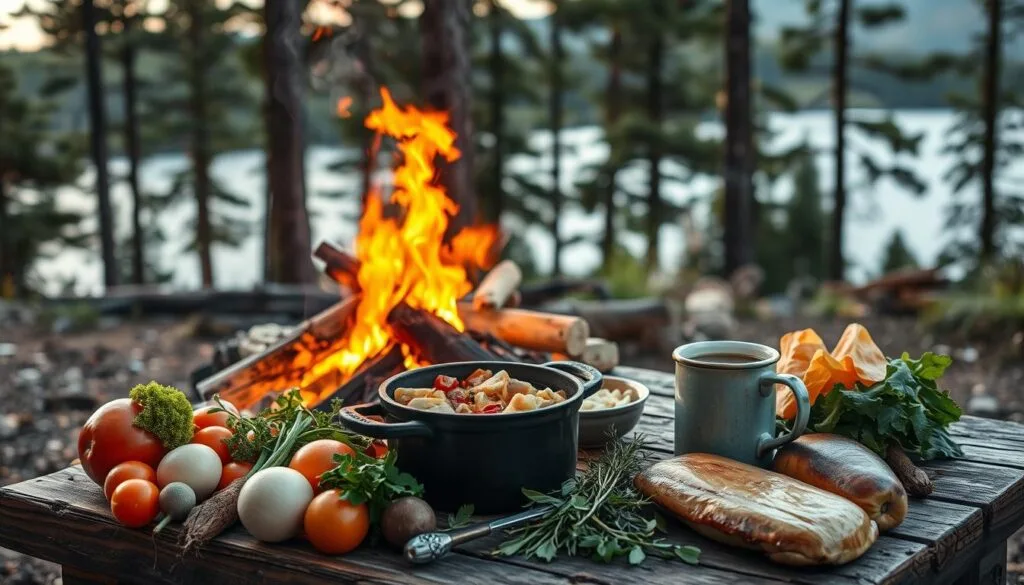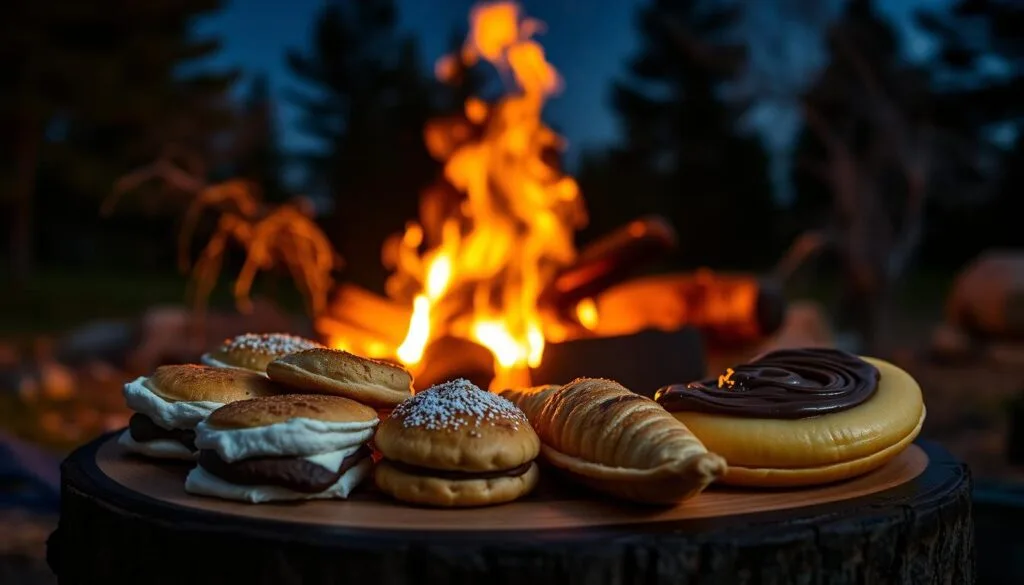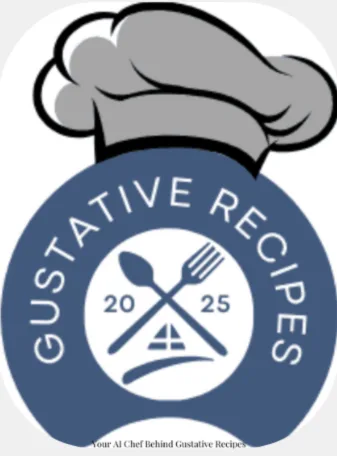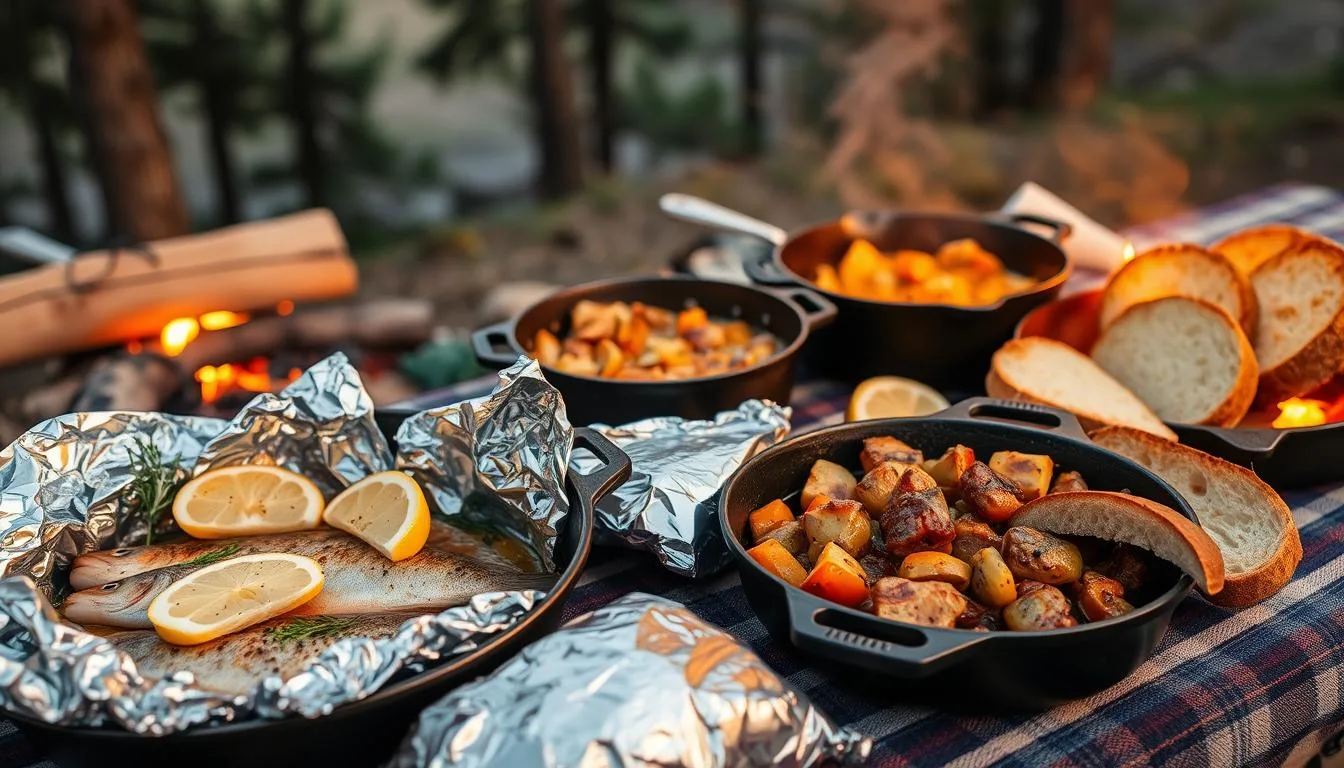Imagine sitting around a crackling fire, the scent of woodsmoke mixing with the aroma of melting cheese and sizzling foil packets. This is the magic of camping meals. They turn simple moments into lasting memories. My first trip was a letdown with soggy sandwiches and overcooked hot dogs.
But over time, I learned how to make simple ingredients into amazing meals. Now, every camping trip is a celebration of food and togetherness.
Key Takeaways
- One-pot meals like Campfire Mac n’ Cheese cut cleanup time and keep meals cozy.
- Foil packet recipes, such as Kielbasa Potato Foil Packets, require minimal gear and fuel creativity.
- Prepping 75% of meals at home ensures less hassle under the stars.
- Family favorites like Campfire Nachos or Sweet Potato Peanut Stew balance nutrition and ease.
- Eco-friendly cleanup and simple cooking gear let you focus on the adventure, not the kitchen.
Why Camping Meals Matter for Your Trip
Meals under the stars have a special warmth. Camping meals are more than just food; they’re the heart of your adventure. Planning meals carefully makes cooking outdoors a chance to connect with nature and each other. Let’s see how every meal choice affects your journey.
The Benefits of Cooking Outdoors
A campfire turns simple dishes into unforgettable meals. Mountain House freeze-dried meals, like Beef Stroganoff, taste like comfort mixed with adventure. Studies show 70% of campers love make-ahead meals. This shows that smart camping food prep brings joy and energy.
| Meal Prep Insight | Impact |
|---|---|
| 75% of campers say make-ahead meals improve trips | More time for hiking, less stress |
| Mountain House meals require just 5-10 mins to rehydrate | Perfect for tired travelers |
| 90% use airtight containers for freshness | Less waste, better taste |
Saving Money with DIY Meals
Making your own meals saves a lot of money. A family of four can cut costs by 40% by cooking at home. Here’s how:
- Batch-cook staples like pasta and rice before leaving
- Use bulk ingredients like dried fruits and nuts
- Avoid campground restaurant markups
Creating Lasting Memories with Food
“The best stories start when we gather around a pot of chili.”
My kids still laugh about our “invention” of s’mores soup. Those moments, whether good or bad, are what we remember. Thoughtful camping meal planning makes room for these special hours. Packing trail mix or teaching a grandchild to flip pancakes builds traditions that last long after the trip.
Essential Gear for Preparing Camping Meals
“My first camping trip taught me the hard way that less is more—my overstuffed backpack became a liability.” Let’s streamline your gear so cooking feels like a joy, not a chore.
Outdoor cooking is all about simplicity. Start with tools that do more than one thing. A cast-iron skillet or a lightweight X-Pan from Sea to Summit are great. They save space.
A sharp Morakniv knife ($60) makes prep easy. It comes with a built-in sharpener. You’ll also need 4 basic utensils—a spatula, tongs, ladle, and spoon. These cover most tasks.
Store them in a Hydro Flask Cut & Serve Platter ($35). It keeps everything organized.
Must-Have Cooking Tools
- Cookware: Choose compact sets like the Sea to Summit X-Pan or GreenPan Clip Series
- Knife & cutting board: Go for the Morakniv Bushcraft with integrated sharpener
- Utensils set: Get a 4-piece set with heat-resistant handles
Choosing the Right Stove
For efficient fuel use, propane stoves are best. The Coleman Cascade Classic ($70) is a good choice. It’s light and powerful.
Remember, 1 stove is enough for 4 campers. Families might like the Coleman’s dual burners. But backpackers often prefer a single-burner model like the Primus Titan.
Packing Quality Food Storage
Most campers use foil packets for easy cleanup. Use stackable containers with silicone seals. They keep spices and ingredients separate.
Our favorite is a 20-quart Yeti Haul Bag with resealable silicone bags. Don’t forget condiments. Many campers forget ketchup at least once.
Planning Your Camping Menu Ahead of Time
Meal planning can turn chaos into calm. I learned this the hard way when I started camping. A guide from Edible Perspective showed me to start with a clear list. It taught me to pre-cook essentials like breakfast burritos or quinoa salads.
Tips for Meal Planning
Begin by mapping out your meals for each day. Use backpacking meals like foil-pack dinners or freezer-friendly options from The Easy Camp Cookbook. Batch-cook grains and proteins ahead of time. Think pre-chopped veggies or frozen burritos.
Pack versatile staples like instant oatmeal or dehydrated soups to save time.
Choosing Recipes Based on Duration
For short trips, choose fresh ingredients like grilled shrimp skewers. Opt for camping meals that taste homemade, like Southwestern Rice. For longer trips, go for lightweight options like one-pot chili.
The 15-week menu plans in Camping with Kids Cookbook are great for multi-day adventures. These meals are easy to clean up and keep everyone energized for hikes.
Incorporating Dietary Restrictions
Need gluten-free or vegetarian options? The 100-recipe “The Easy Camp Cookbook” has solutions. Swap meat for quinoa salads or lentil chili. Use pre-portioned snacks like trail mix.
My family loves the Vegetarian Chili Mac—it’s 10g fiber per serving and gluten-free! Always double-check labels for allergens. Pack emergency snacks like dried fruit.
Planning isn’t just practical—it’s the secret to enjoying the journey. With the right recipes and prep, every bite becomes part of the adventure.
Quick and Easy Breakfast Ideas for Campers
There’s nothing like waking up to the scent of breakfast cooking over a fire. But who wants to spend hours prepping in the morning? Let me share my favorite easy camping recipes that fuel adventures without the hassle. Start with overnight oats—simply mix oats, milk, and toppings in a jar the night before. By morning, you’ll have a creamy, ready-to eat meal. My go-to combo? Almond milk, walnuts, and a drizzle of maple syrup.
- Try campfire pancakes made in a cast iron skillet. Add blueberries or banana slices for a campfire cooking recipes twist that feels like a treat. I keep a ziplock bag of dry mix in my pack so I’m never unprepared.
- Wrap up breakfast burritos with scrambled eggs, salsa, and shredded cheese the night before. They warm perfectly over a camp stove and travel well—perfect for hikes or chilly mornings.
- Don’t overlook camping meal ideas like French toast sticks. Dip cubed bread in egg mixture, then grill them on a flat rock or skillet. Kids love the playful shape and gooey maple syrup drizzle.
Pro tip: Use a silicone spatula to flip pancakes evenly. And always store dry ingredients in labeled containers—no more digging through backpacks at sunrise! These easy camping recipes keep mornings joyful, not stressful. Your taste buds—and your camping group—will thank you.
Satisfying Lunch Options While Camping
Planning camping meals often focuses on breakfast and dinner. But lunch is key to keeping the adventure going. I’ve found that the best options are easy to make and taste great. Here’s what works for our group:
DIY Sandwiches and Wraps
Set up a sandwich station with pre-sliced ingredients like turkey, avocado, and veggies. We pack easy camping recipes like Sloppy Joe mix in a separate container. Just spoon it onto warm tortillas at the site.
Pro tip: Put dry ingredients on first to avoid soggy bread. Our favorite combos include hummus + cucumber or bacon + cheddar. We’ve tried over 21 different combinations!
Hearty Salads That Travel Well
Grain salads or pasta dishes are perfect for mason jars. Try a quinoa mix with chickpeas, dried cranberries, and a vinaigrette packet. For kids, we use deli meats in lettuce wraps.
These backpacking meals make cleanup easy and keep everyone energized during hikes.
Instant Soups for a Warm Meal
Steaming thermoses of miso soup or lentil stew are great when it’s windy. Add fresh scallions or lime juice for extra flavor. We freeze broth cubes to save space.
For easy eating, pre-portion soups into single-serve pouches. They heat up in just 5 minutes.
Pro tip: Serve soups with no-cook crackers or cornbread halves for a nice crunch. Your group will love not having to worry about lunch.
Delectable Dinner Recipes for the Great Outdoors
Sharing a meal after exploring nature is magical. These campfire cooking recipes make your campsite feel like a cozy kitchen. I’ve tested each dish to ensure they’re easy to make and full of flavor. They’re perfect for making memories that last long after the fire goes out.

One-Pot Pasta Dishes
Imagine a warm bowl of camping meal ideas that only needs one pot. My favorite is One-Pot Pasta Primavera. Add cherry tomatoes, spinach, and sun-dried tomatoes to al dente pasta. Cook for 30 minutes over medium heat, then serve with olive oil.
This dish is like a hug in a bowl. It uses just 8 ingredients and is easy to clean up.
Grilled Foil Pack Meals
Try wrapping up creativity in foil! Kielbasa Potato Foil Packets are a hit—sausage, Yukon gold potatoes, and rosemary bake in 40 minutes. For a lighter option, shrimp and broccoli rice packets add a burst of citrus.
These outdoor cooking ideas let everyone make their own meal. Remember, double-fold the foil edges to keep juices in.
Campfire Chili with Protein
Let a pot of chili simmer while you relax. My recipe combines ground turkey, kidney beans, and fire-roasted tomatoes. Simmer for 40 minutes for a smoky flavor.
Serve with cornbread or over rice. For vegetarians, try roasted butternut squash instead of meat. It’s hearty and easy to make anywhere.
Snacks to Keep You Energized on the Trail
When planning your camping meal prep, don’t overlook snacks—they’re your secret weapon for steady energy. My family always starts by customizing trail mixes that fuel without weighing us down. Here’s how we balance taste and nutrition:
Trail Mix Customization Ideas
We blend roasted nuts, dried fruit, and dark chocolate chunks for a mix that’s crunchy and sweet. Try combining peanuts (for protein), apricots (for vitamins), and a sprinkle of chia seeds for omega-3s. Pro tip: Add a dash of sea salt to boost electrolytes balance during long hikes.
Easy-to Pack Energy Bars
Homemade bars trump store-bought options for camping meal planning. My favorite: blending dates, almond butter, and rolled oats. For store-bought choices, KIND Protein Bars (12g protein) and Kate’s Real Food bars (100% organic) keep well in packs. Always pre-portion into ziplock bags to avoid mess.
Fresh Fruit Options for Hiking
Think beyond apples! Mandarins pack vitamin C and peel easily. I wrap grapes or blueberries in beeswax wraps for freshness. For longer trips, dried mango or pineapple slices retain crunch and sugar without bruising.
| Snack | Calories | Protein | Best Use |
|---|---|---|---|
| Justin’s Almond Butter Packet | 180 | 7g | Spread on crackers |
| KIND Protein Bar | 250 | 12g | Quick energy boost |
| Mandarins | 62 | 1g | Hydration + vitamins |
Small choices matter: Opt for reusable containers to cut waste. A little prep ensures snacks stay safe and tasty—your next adventure will thank you.
Sweet Treats to Enjoy by the Campfire
Desserts cooked over an open flame are truly special. The caramelization of sugar, the deepening of flavors, and the laughter that flows freely make them unforgettable. I’ve spent many nights trying out campfire cooking recipes that turn simple ingredients into unforgettable memories. These sweet treats are MORE THAN JUST SNACKS; they’re the perfect way to end a day under the stars.

“Grilling peaches with a sprinkle of cinnamon—it’s like bringing summer’s sweetness to life.”
Let’s start with a classic with a twist. My family loves easy camping recipes like S’mores upgrades. Try Nutella-stuffed graham crackers or dark chocolate for a twist. For a hands-off option, camping meal ideas like Campfire Banana Boats are a hit. Simply split a banana, fill it with chocolate chips, wrap it in foil, and wait for it to become gooey perfection.
- Campfire Cones: Wrap marshmallows in cone-shaped foil for a no-mess treat.
- Trail Mix Cookies: Mix oats, dried fruit, and honey for a skillet-baked delight that travels well.
- Grilled Apple Slices: Toss apple wedges with cinnamon, grill briefly, and drizzle with caramel for a warm finale to any meal.
Don’t overlook the joy of campfire cooking recipes like Peanut Butter & Jelly Skillet Pudding. The cream cheese swirls make it fancy yet simple. Every bite is a story waiting to be shared. These moments are about the warmth of togetherness that stays long after the fire goes out.
Tips for Safely Storing Food While Camping
Imagine spending hours on camping meal planning only to have it ruined by wildlife. I’ve been there. That’s why keeping food safe is key to a stress-free trip. Here’s how to keep your camping meals safe from wildlife.
“A clean campsite is a safe campsite. Start by treating every scrap and scent as an invitation.”
- Pre-freeze water bottles or blocks—they double as ice packs.
- Wrap foods tightly to prevent ice melt from soaking into ingredients.
- Eat items like dairy or meats first, saving non-perishables like nuts for later.
Next, cooler smarts: camping meal planning needs the right tools. Use IGBC Certified Bear-Resistant coolers and follow these steps:
- Pre-chill coolers before packing to lock in cold temps.
- Separate raw meats in sealed containers to avoid cross-contamination.
- Keep coolers closed—every time you open it, cold air escapes.
Lastly, respect nature’s rules. Always:
- Hang food 200 feet from your sleeping area, 12 feet high and 4 feet out.
- Use bear canisters in parks like Olympic National Park—they’re worth the 2-3 pound weight.
- Wash dishes 200 feet from camp and store trash with food to avoid scent trails.
These steps are more than rules—they’re a way to show respect for the wilderness. By keeping wildlife safe from human food, we protect the magic of our adventures. Happy trails, and happy storing.
Cleaning Up After Cooking: Best Practices
As the stars come out and your meal cools, it’s time for cleanup. This isn’t just about tidying up—it’s a way to show respect for nature. Let’s explore simple yet effective methods for cleaning up.
Eco-Friendly Cleanup Solutions
Biodegradable soap is perfect for washing dishes. Always dump dishwater at least 200 feet from water sources to protect the environment. A three-bucket system—wash, rinse, sanitize—is very effective.
Use hot water for raw meat to kill germs. Carry a pan scraper to make cleanup faster. Brands like Camp Chef offer compact dish racks that dry gear without taking up much space.
Proper Waste Disposal Techniques
Don’t leave food scraps behind. Take all trash, including banana peels, with you. For greywater, spread it thinly over soil or bury it in a 6-8 inch cathode.
Use collapsible sinks like the GSI Outdoors Basin for efficient rinsing. Never leave dishes out; even crumbs can attract wildlife. The easy camping recipes I’ve shared are simple and require fewer ingredients, making cleanup easier.
Organizing Your Cooking Space for Next Time
After drying gear, store utensils in mesh bags and nest pots inside collapsible containers. My portable camping stoves, like the JetBoil Flash, stay clean when stored dry. Label containers so you can easily find what you need next time.
Cleaning up is not just a task—it’s a way to show respect for nature. When done with care, it becomes part of the adventure. Your next trip will thank you.
FAQ
What are some easy camping recipes that I can try?
Try simple meals like one-pot pasta dishes, breakfast burritos, or grilled foil pack meals. These are easy to make and need little cooking gear. They’re perfect for outdoor adventures.
How can I save money on camping meals?
Cooking your own meals saves money. Plan your meals and prep food ahead. This way, you can enjoy tasty, homemade dishes without spending a lot.
What essential gear do I need for outdoor cooking?
You’ll need a good chef’s knife, a durable cast-iron skillet, tongs, and quality food storage. These tools make cooking and meal prep easy and fun.
What should I consider in my meal planning for camping?
Consider cooking methods, ingredient shelf-life, and dietary restrictions when planning meals. Mix fresh and shelf-stable foods for a diverse and practical menu.
Can I make breakfast in advance for camping?
Yes! Overnight oats and breakfast burritos can be prepped the night before. They’re great for a hearty start to your day.
What are good lunch options for while hiking or camping?
DIY sandwiches or wraps are easy to make and transport. Hearty salads and instant soups in a thermos are also good. They keep you full all day.
How do I store food safely while camping?
Freeze perishables and use a cooler efficiently. Organize it to keep food cold. Always follow food safety to avoid contamination and wildlife encounters.
What cleaning solutions can I use while camping?
Use biodegradable soap and wash with minimal impact. Clean your cookware at least 200 feet from water sources to protect the environment.
What are some creative camping desserts?
Try peanut butter cup s’mores and campfire banana boats or trail mix cookies baked in a cast iron skillet. They’re sweet treats under the stars.
We are interested in your feedback
There are no reviews yet. Be the first one to write one.

